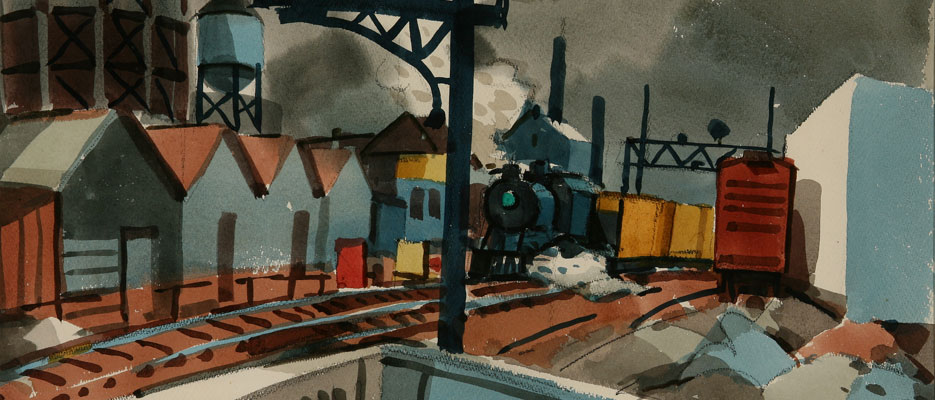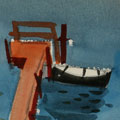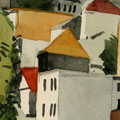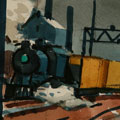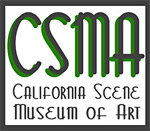“The foreground is just an access or entry. The less you do to a foreground, the better.” - George Post
In the words of Erin Carroll of the Sullivan Goss Gallery, “George Post embodies a man deeply rooted and in love with the West. His artistic portrayals of the charming city of San Francisco to the wine country of Sonoma Valley and on to the rugged coasts of Mendocino cements this adoration. When he painted, Post required that he be outdoors, it is possible that the images flowed directly from life and onto his paper.” Indeed, Post seemed to want to glorify the situational beauty of a place and had a great reverence for the details in the world around him. He had both an appreciation for the natural world and the eye of an engineer; he was attracted to the inner workings of machinery. According to Gordon McClelland’s The California Style, Post “is known for transparent watercolors of equipment and engines.” It seems the design of objects intrigued hi artistically.
Although he began making art in commercial industries of advertising and printing, he was inspired to explore the watercolors when he encountered the work of Stanley Wood in the late 1920s. He devoted more time to the medium at that time, producing watercolor works on a daily basis. After enjoying a stint of dedicated travel in the late 1930s, Post committed himself to plein air watercolor practice and he painted almost everyday. Like many other California Scene painters, Post used his artistic prowess to serve his country during WWII. While working as a cargo storage planner for military ships. He also had ample opportunities to paint watercolors of the ships and harbor while working on the docks.
Post's watercolors took a more modern turn after the war, and his geometric abstractionist works gained him new acclaim in the California art community. His style rode a fine line, being “modern enough to be exhibited in the progressive art shows and representational enough to be included in more conservative ones,” according to McClelland. He was less concerned with realism and more focused on design, careful composition, stylistic spontaneity, and the mood cast by light and shadow.
George Post’s artworks have been exhibited at the Beaux Arts Gallery, San Francisco Art Center, San Francisco Museum of Modern Art, California Pacific International Expo, Watercolor Society, Oakland Art Gallery, Los Angeles County Museum of Art, Laguna Beach Museum, Springfield Museum, Challis Gallery, Oakland Museum, Seattle Museum, San Diego Museum, Santa Barbara Museum, and Mills College, among other places.
In the words of Erin Carroll of the Sullivan Goss Gallery, “George Post embodies a man deeply rooted and in love with the West. His artistic portrayals of the charming city of San Francisco to the wine country of Sonoma Valley and on to the rugged coasts of Mendocino cements this adoration. When he painted, Post required that he be outdoors, it is possible that the images flowed directly from life and onto his paper.” Indeed, Post seemed to want to glorify the situational beauty of a place and had a great reverence for the details in the world around him. He had both an appreciation for the natural world and the eye of an engineer; he was attracted to the inner workings of machinery. According to Gordon McClelland’s The California Style, Post “is known for transparent watercolors of equipment and engines.” It seems the design of objects intrigued hi artistically.
Although he began making art in commercial industries of advertising and printing, he was inspired to explore the watercolors when he encountered the work of Stanley Wood in the late 1920s. He devoted more time to the medium at that time, producing watercolor works on a daily basis. After enjoying a stint of dedicated travel in the late 1930s, Post committed himself to plein air watercolor practice and he painted almost everyday. Like many other California Scene painters, Post used his artistic prowess to serve his country during WWII. While working as a cargo storage planner for military ships. He also had ample opportunities to paint watercolors of the ships and harbor while working on the docks.
Post's watercolors took a more modern turn after the war, and his geometric abstractionist works gained him new acclaim in the California art community. His style rode a fine line, being “modern enough to be exhibited in the progressive art shows and representational enough to be included in more conservative ones,” according to McClelland. He was less concerned with realism and more focused on design, careful composition, stylistic spontaneity, and the mood cast by light and shadow.
George Post’s artworks have been exhibited at the Beaux Arts Gallery, San Francisco Art Center, San Francisco Museum of Modern Art, California Pacific International Expo, Watercolor Society, Oakland Art Gallery, Los Angeles County Museum of Art, Laguna Beach Museum, Springfield Museum, Challis Gallery, Oakland Museum, Seattle Museum, San Diego Museum, Santa Barbara Museum, and Mills College, among other places.
California Scene Painting Timeline:
1906: Born in Oakland, CA.
1924-1926: Studied at the California School of Fine Arts
1927: Entered into the advertising, printing and watercolor painting arts industries.
1930s: Began exhibiting critically acclaimed watercolors of the greater San Francisco Bay area.
1940: Taught at Stanford University
1945 - 1955: Post associated himself with the Brandt-Dike Summer School, established by fellow California Scene Painter Phil Dike.
1947-72: Served as tenured fine arts professor at the California College of Arts and Crafts.
1951-52: Joined faculty at San Jose State College
Post lived in San Francisco, where he passed in1997.
